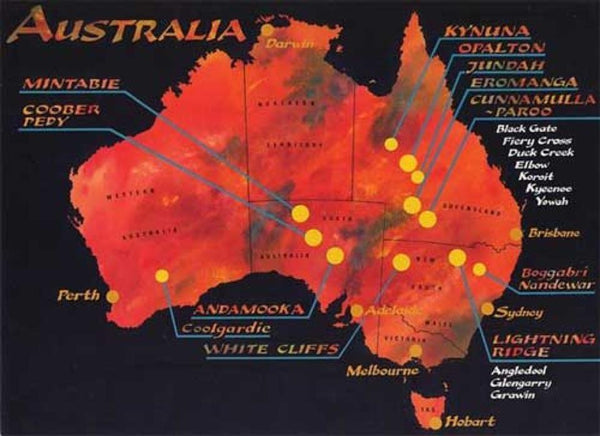Australian Opals
Australian opals are the most sort after opal in the world and arguably the most spectacular and valuble gem on earth. Australia is lucky enough to have the types and quality of opal that can not be found anywhere else.
Here at sunriseopals we sell only 100% solid, natural Australian opals so you can be assured that your purchase is of the highest quality. The majority of Australian opal is sedimentary and found along the Artesian Basin. This very unique structure has created conditions have lead to the formation of our amazing national gemstone, OPAL!!!
Throughout the Artesian Basin the host rocks change which lends slight differences to the opal from area to area. From the boulder opals in western Queensland to the stunning opals of Lightening Ridge NSW all the way south to Coober Pedy in South Australia - it is Australian Opal, the finest opals in the world, sought after by collectors and opal jewellery fanatics all over the globe.
These unique and rare conditions came about in the area where the Lost Inland Sea was, so not only does Australia have the most amazing opal in the world but also some of the best fossils and opalised fossils in the world.

110 million years ago the Australian landmass was connected to Antarctica, New Zealand and South America as the southern super-continent, Gondwana. Dinosaurs and their relatives dominated landscapes forested with pines, ferns and palms that fringed the shallow sea. At the edge of this ancient continent, fragments of the remains of these plants and animals accumulated in the sands of the seabed. Over millions of years mineral-rich water preserved these fossils molecule by molecule with hydrated silica, the building blocks of precious opal. Today Australia's opal fields yield some of the rarest, most beautiful and valuable fossils in the world.
The sediments of the Australian opal fields (Quilpie, Eromanga, Yowah, Koroit, Andamooka, Coober Pedy, Lightning Ridge, White Cliffs) were formed on the floor of an ancient shallow sea where plants, marine-life and occasionally the bones and teeth of animals were preserved. Over millions of years, mineral-rich waters from deep within the earth permeated this rock, transforming these fossils into opal. As they tunnel through these sediments searching for precious opal, miners sometimes find these fossils.
